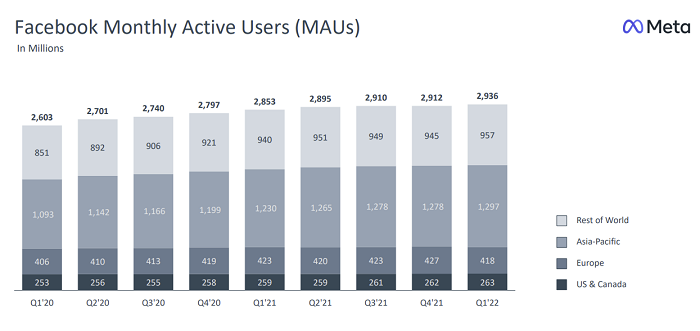SOCIAL
Facebook User Growth Back on Track, Revenue Declines in Q1

Facebook has managed to get its user growth back on track, lessening market concern, though revenue growth has slowed in Q1 2022, partly due to the war in Ukraine, among other issues.
In its first performance update of the year, Meta has once again underlined its enduring performance capacity, even as it focuses on the next stage of digital connection, after a decline in usage last report had some questioning whether it had plateaued, and was now on the decline in the eyes of users.
First off, on daily actives – Facebook DAUs came in at 1.96 billion on average for March 2022, an increase of 4% year-over-year
The majority of Facebook usage growth came, once again, from the Asia Pacific region, where the app is still branching into developing markets, and seeing steady take-up.
Though you will also note that Facebook’s daily usage rates declined by 2 million in Europe, and only saw a slight increase in the US. Facebook usage has fluctuated in both markets for some time, and it may well be that Facebook has indeed reached its optimal take-up in these regions.
Though at the same time, a huge amount of people are still logging into Facebook in these markets every single day. That likely speaks to the key connective role that the app now plays on the modern interactive process – though I would still like to see just how long people are actually spending in the app, and how many are simply logging on to check their notifications, before spending the majority of their online time elsewhere.
In terms of monthly actives, Facebook rose to 2.94 billion, an increase of 3% year-over-year.

The decline in European usage is much more pronounced here (-9 million), which does seem to point to declining popularity of the app in some markets.
Though that also likely relates to Russian bans. Facebook reportedly had over 70 million users in Russia as of February 2022, before Russia’s communications regulator moved to block Facebook access entirely in early March, in response to Meta’s restriction of Russian state media outlets.
In which case, Facebook likely lost a lot more active users than what’s shown here – but that’s not Meta’s fault, nor is it reflective of a trend away from the app.
But it could make Meta’s user numbers look a lot worse in Europe in Q2, depending on how things progress.
Overall, however, the numbers show that Facebook remains hugely popular, while Meta’s ‘Family of Apps’ chart, which includes unique users across Facebook, Messenger, Instagram and WhatsApp, has also continued to inch up.

The variance between this chart and Facebook usage in isolation suggests that there are around 700 million users not on Facebook that are logging into these other apps each month.
Meta doesn’t break down the usage figures for its other platforms, but considering that WhatsApp has over 2 billion users, in a broad range of markets, it does seem to point to there being a big crossover between Facebook and Instagram usage. Instagram reportedly has over 2 billion users in its own right, though Meta has not officially confirmed this stat.
But again, the more interesting consideration here is how long people are spending in Meta’s apps – because while most people will log on to see what their friends and family have shared each day, I suspect that many are now spending a lot more time in TikTok and YouTube instead.
This seems like the much more informative stat, and Meta hasn’t provided anything official on this front for some time.
In terms of revenue, Meta brought in $27 billion for the quarter, up 7% year-over-year:

The decline in revenue in its biggest two ad markets will be a concern, though Meta does note that ad impressions delivered across its apps increased by 15% year-over-year.
Meta’s still grappling with Apple’s ATT update, which has limited its data collection capacity, which it’s previously noted would drag its results down by around $10 billion in 2022 alone. Meta also says that revenue ‘softness in the back half of the first quarter’ was exacerbated by the war in Ukraine, while at the same time, it continues to invest in emerging technologies, driving increased spend.

That’s an inevitable impact of its focus on the future, but that focus is also, in Meta’s view, what will secure its ongoing performance, and there’s much to come on this front.
In many ways, the company is in a transition period, which Meta itself has explained to the market within its recent statements. As it looks towards the next stage of connection, that, inevitably, will impact on current day performance. Increased R&D cost is the most obvious hit, but it also means that virtually every project, within each of its apps, now has to build with an eye toward the future, which means longer development cycles, increased complexity, and more labor time as a result.
The Metaverse may well be the future, but shareholders are essentially betting on Zuck’s nous here, in the hopes that he’s right – because as we’ve seen, Meta’s core apps are already feeling the pinch, and it doesn’t seem like it’s shifting its approach, with costs continuing to rise, and more resources being directed towards increasingly expensive hardware releases.
If Meta truly believes in the Metaverse shift, that will likely also see it take another hit on the retail costs of its VR headsets, and eventually its AR glasses, because the real money is in mass adoption, and expanding Metaverse engagement.
In essence, while the market probably isn’t overly excited Meta’s results now, it’s not likely to look a lot better for some time yet. And if the Metaverse ends up taking a decade to become the next plain of digital existence, as Meta has predicted, that’ll definitely stretch the patience of $FB holders.
For users, Meta will stay the path with increased eCommerce integrations, and more opportunities for creators to make money in its apps. The latter could also feed into the Metaverse as well, with a new fund already set up to support VR creators, and more education programs to guide artists and influencers into the next space, in the hopes that they’ll bring their audiences with them.
Instagram remains focused on beating TikTok at its own game, while WhatsApp is still working on business tools, which could major potential in developing markets.
But really, it’s all about the Metaverse, and setting the foundation for the next stage. There are exciting developments here, but they’re not coming soon – it’s not just a matter of flicking a switch and ushering in the next stage.
Which means that a level of patience is required, something that the market is not renowned for.
SOCIAL
Snapchat Explores New Messaging Retention Feature: A Game-Changer or Risky Move?

In a recent announcement, Snapchat revealed a groundbreaking update that challenges its traditional design ethos. The platform is experimenting with an option that allows users to defy the 24-hour auto-delete rule, a feature synonymous with Snapchat’s ephemeral messaging model.
The proposed change aims to introduce a “Never delete” option in messaging retention settings, aligning Snapchat more closely with conventional messaging apps. While this move may blur Snapchat’s distinctive selling point, Snap appears convinced of its necessity.
According to Snap, the decision stems from user feedback and a commitment to innovation based on user needs. The company aims to provide greater flexibility and control over conversations, catering to the preferences of its community.
Currently undergoing trials in select markets, the new feature empowers users to adjust retention settings on a conversation-by-conversation basis. Flexibility remains paramount, with participants able to modify settings within chats and receive in-chat notifications to ensure transparency.
Snapchat underscores that the default auto-delete feature will persist, reinforcing its design philosophy centered on ephemerality. However, with the app gaining traction as a primary messaging platform, the option offers users a means to preserve longer chat histories.
The update marks a pivotal moment for Snapchat, renowned for its disappearing message premise, especially popular among younger demographics. Retaining this focus has been pivotal to Snapchat’s identity, but the shift suggests a broader strategy aimed at diversifying its user base.
This strategy may appeal particularly to older demographics, potentially extending Snapchat’s relevance as users age. By emulating features of conventional messaging platforms, Snapchat seeks to enhance its appeal and broaden its reach.
Yet, the introduction of message retention poses questions about Snapchat’s uniqueness. While addressing user demands, the risk of diluting Snapchat’s distinctiveness looms large.
As Snapchat ventures into uncharted territory, the outcome of this experiment remains uncertain. Will message retention propel Snapchat to new heights, or will it compromise the platform’s uniqueness?
Only time will tell.
SOCIAL
Catering to specific audience boosts your business, says accountant turned coach

While it is tempting to try to appeal to a broad audience, the founder of alcohol-free coaching service Just the Tonic, Sandra Parker, believes the best thing you can do for your business is focus on your niche. Here’s how she did just that.
When running a business, reaching out to as many clients as possible can be tempting. But it also risks making your marketing “too generic,” warns Sandra Parker, the founder of Just The Tonic Coaching.
“From the very start of my business, I knew exactly who I could help and who I couldn’t,” Parker told My Biggest Lessons.
Parker struggled with alcohol dependence as a young professional. Today, her business targets high-achieving individuals who face challenges similar to those she had early in her career.
“I understand their frustrations, I understand their fears, and I understand their coping mechanisms and the stories they’re telling themselves,” Parker said. “Because of that, I’m able to market very effectively, to speak in a language that they understand, and am able to reach them.”Â
“I believe that it’s really important that you know exactly who your customer or your client is, and you target them, and you resist the temptation to make your marketing too generic to try and reach everyone,” she explained.
“If you speak specifically to your target clients, you will reach them, and I believe that’s the way that you’re going to be more successful.
Watch the video for more of Sandra Parker’s biggest lessons.
SOCIAL
Instagram Tests Live-Stream Games to Enhance Engagement

Instagram’s testing out some new options to help spice up your live-streams in the app, with some live broadcasters now able to select a game that they can play with viewers in-stream.
As you can see in these example screens, posted by Ahmed Ghanem, some creators now have the option to play either “This or That”, a question and answer prompt that you can share with your viewers, or “Trivia”, to generate more engagement within your IG live-streams.
That could be a simple way to spark more conversation and interaction, which could then lead into further engagement opportunities from your live audience.
Meta’s been exploring more ways to make live-streaming a bigger consideration for IG creators, with a view to live-streams potentially catching on with more users.
That includes the gradual expansion of its “Stars” live-stream donation program, giving more creators in more regions a means to accept donations from live-stream viewers, while back in December, Instagram also added some new options to make it easier to go live using third-party tools via desktop PCs.
Live streaming has been a major shift in China, where shopping live-streams, in particular, have led to massive opportunities for streaming platforms. They haven’t caught on in the same way in Western regions, but as TikTok and YouTube look to push live-stream adoption, there is still a chance that they will become a much bigger element in future.
Which is why IG is also trying to stay in touch, and add more ways for its creators to engage via streams. Live-stream games is another element within this, which could make this a better community-building, and potentially sales-driving option.
We’ve asked Instagram for more information on this test, and we’ll update this post if/when we hear back.
-

 PPC7 days ago
PPC7 days ago19 Best SEO Tools in 2024 (For Every Use Case)
-
SEARCHENGINES6 days ago
Daily Search Forum Recap: April 19, 2024
-

 WORDPRESS7 days ago
WORDPRESS7 days agoHow to Make $5000 of Passive Income Every Month in WordPress
-

 SEO7 days ago
SEO7 days ago25 WordPress Alternatives Best For SEO
-

 WORDPRESS5 days ago
WORDPRESS5 days ago13 Best HubSpot Alternatives for 2024 (Free + Paid)
-

 WORDPRESS6 days ago
WORDPRESS6 days ago7 Best WooCommerce Points and Rewards Plugins (Free & Paid)
-

 MARKETING6 days ago
MARKETING6 days agoBattling for Attention in the 2024 Election Year Media Frenzy
-

 MARKETING7 days ago
MARKETING7 days agoTinuiti Marketing Analytics Recognized by Forrester
















You must be logged in to post a comment Login